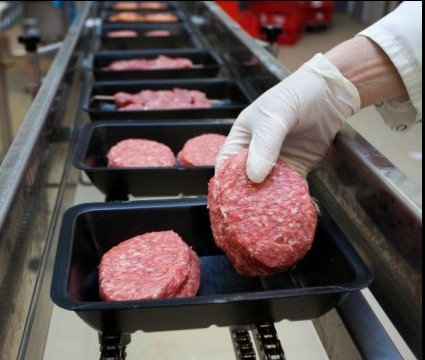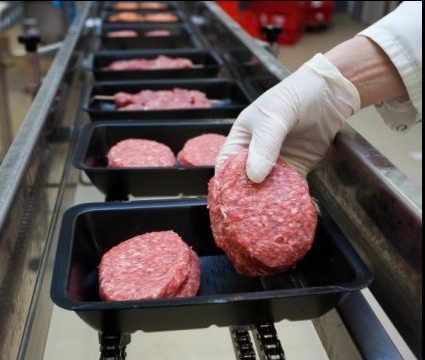 A Colorado company recalled the equivalent of 1.86 million Quarter Pounders. In Meat Wagon, we round up the latest outrages of the meat and livestock industries.
A Colorado company recalled the equivalent of 1.86 million Quarter Pounders. In Meat Wagon, we round up the latest outrages of the meat and livestock industries.
—————————————
Sometimes I think I write a little too much about the meat industry. But the news it generates is so consistently grave, and so generally underreported, that I can’t resist. Moreover, outbreaks of E. coli and MRSA are really ecological markers–feedback that our way of producing meat is deeply unsustainable and really quite dangerous. We ignore these news flashes from our ecoystem at our peril. So I scribble on.
Here’s the latest: In Colorado, 14 people have fallen ill from hamburger meat tainted with antibiotic-resistent salmonella, the Boulder newspaper Daily Camera reports. (Note that antibiotic-resistent salmonella is distinct from MRSA, an antibiotic-resistant staph infection, increasingly associated with industrial meat production, that kills 20,000 Americans each year–more than AIDS.)
The bad burger came from a Denver-based supermarket chain called King Soopers, which has now recalled 466,236 pounds of it.
It’s Meat Wagon tradition to convert such abstract-seeming figures into what we like to call Quarter Pounder Equivalents. According to our proprietary computer models, King Soopers has officially released enough suspect beef for McDonald’s to crank out approximately 1.86 million Quarter Pounders.
In addition to Colorado, the tainted meat has been distributed to retail outlets in Kansas, Missouri, Nebraska, New Mexico, Utah and Wyoming. That’s our food system–concentrating pathogens and sending them far and wide.
Again, a gaping whole has been exposed in our food-safety system. The USDA’s FSIS, which oversees meat safety, announced the recall on July 22; according to the Daily Camera, people in Colorado “became ill between June 13 and 28 after buying their meat between June 1 and 14.” So it took more than a month to recall 1.86 million Quarter Pounder Equivalents after people came down with antibiotic-resistant salmonella. What’s the rush, guys?
Of course, the meat actually entered the food system as far back as May 23. Nice work, inspectors!
But the underlying issue is the meat industry’s reliance on antibiotics to keep animals alive while in cramped, flithy conditions and on questionable diets. As Michael Pollan reported in his classic 2002 article “Power Steer,” antibiotics are a routine fact of cow life on feedlots. In fact, if you’re going to feed corn and corn byproducts to ruminants that evolved to eat grass, antibiotics are necessary. Describing a visit to a large feedlot in Kansas, Pollan wrote:
First stop was a hopper filled with Rumensin, a powerful antibiotic that No. 534 [the calf Pollan had bought] will consume with his feed every day for the rest of his life. Calves have no need of regular medication while on grass, but as soon as they’re placed in the backgrounding pen, they’re apt to get sick. Why? The stress of weaning is a factor, but the main culprit is the feed. The shift to a ”hot ration” of grain can so disturb the cow’s digestive process–its rumen, in particular –that it can kill the animal if not managed carefully and accompanied by antibiotics.
Pollan goes on to report that:
In a shed attached to the mill sit vats of liquid vitamins and synthetic estrogen; next to these are pallets stacked with 50-pound sacks of Rumensin and tylosin, another antibiotic.
Yum! Nor is intentionally spiking feed rations with Rumensin and tylosin the only way beef cows are exposed to antibiotics. Sometimes they’re inadvertently present in the feed itself. Amid the biofuel boom of recent years, feedlot operators have been putting drastically more distillers grains–a byproduct of corn-based ethanol–into cattle rations. As I’ve reported before, most ethanol makers routinely use antibiotics in production process–and the FDA recently found significant antibiotic residues in distillers grains. FDA researchers detected penicillin, virginiamycin, erythromycin, and tylosin. Tylosin is one of the two identified by Pollan as common feedlot fodder.
But wait, it gets worse. Antibiotic resistance has already reared its head at ethanol plants. In a recent article, the Associated Press quotes a University of Minnesota researcher who says he found resistant bacteria in distillers grains “when he sampled bacteria at four Midwest ethanol plants several years ago.” So the FDA itself has found antibiotic residues in distillers grains, and independent researchers have found resistant bacterial strains in the stuff. What have regulators done to keep distillers grains out of feedlots? Bugger-all, as the British say.
(The Institute for Agriculture and Trade Policy recently put out an excellent short primer (PDF) on the issue of antibiotics and distillers grains; and the blog Food Poison Journal has a nice backgrounder on the recent history of antibiotic-resistant salmonella.)
Anyone for a House bill that would ban routine use of antibiotics in animal farms? “The farm [read: agribusiness] lobby’s opposition makes its [the bill’s] passage unlikely,” The New York Times reported recently. Too bad it’s that simple.
Side of PBDE with that salmonella burger?
One thing you feel safe about when considering a typical U.S. burger patty, chicken breast, or pork chop: It’s not likely to burst into flames on the skillet and burn your house down.
Okay, that’s probably not the most appropriate lead-in to the next stop on the Meat Wagon, but it’s Friday. Get this, from Environmental Health News:
People who eat meat and poultry have significantly higher levels of common flame retardants compared to vegetarians.
Ouch. The topic here is a study (abstract) by Boston University researchers measuring levels of PBDEs, once a commonly used flame retardant, in the bodies of meat eaters and vegetarians.
Guess which side won? “Vegetarians had 23-27 percent less PBDEs circulating in their serum as compared to meat-eaters,” reports EHN. Chicken seemed to be the main culprit.
Serum levels of 5 different PBDEs were associated with eating poultry. People who more poultry had higher levels of the PBDEs. Poultry fat was the greatest contributor to the body burden of PBDEs.
But red meat fared poorly, too. “Red meat intake was associated with two of the measured PBDE levels,” EHN reports. Consumption of fish and dairy, however, showed no effect.
In terms of demographics, levels of PBDEs skewed in the following order: “males, the youngest age group examined (12-19 yrs old), the poor, and the underweight (subjects with lowest BMI).”
This is pretty devastating news for a nation that consumes more than a half pound of meat per day per capita. What are the health implications? EHN:
PBDEs accumulate in the liver, kidney and thyroid gland and are known endocrine disruptors. Chronic exposure and elevated levels lead to disruption of estrogen and thyroid systems. Animal and epidemiological studies link PBDE exposure to several types of reproductive and nervous system impairments.
And here’s how Environmental Working Group describes the situation:
A growing body of research in laboratory animals has linked PBDE exposure to an array of adverse health effects including thyroid hormone disruption, permanent learning and memory impairment, behavioral changes, hearing deficits, delayed puberty onset, decreased sperm count, fetal malformations and, possibly, cancer. Research in animals shows that exposure to brominated fire retardants in-utero or during infancy leads to more significant harm than exposure during adulthood, and at much lower levels.
So how are flame retardants, of all things, making their way into the meat supply? That remains a mystery. From a Science Daily report on the study:
Although it is not known how flame retardants get into commercial animal products, possibilities include the contamination of animal feed, contamination during processing or packaging and general contamination of the environment. PBDEs accumulate in fat tissue and resist degradation in the environment.




